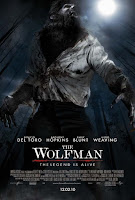It's still October—Hallowe'en month. And things are getting hairier as we head for November. ("No-shave November").
Benicio Del Toro's dream project of a modern...er, make that period remake of The Wolf Man (1941) has had more transformations than a month with two full moons! There have been two directors, settling on Joe Johnston, a litter of writers and re-writers, two scores—one by Danny Elfman, the other by Paul Haslinger, then reverting back to the Elfman score—a pack of editors, including the legendary Walter Murch, all trying to beat this one into shape. Whether this is studio interference or the "creative differences" that emerges when the star is The Big Dog is not known, but there've been a lot of changes on The Wolfman, some of them quite hairy.*
You can tighten up the editing, change the score, even bleed the color out of the thing, but if the script is mangey, no amount of post-production wizardry can save it. I'd say something about "lipstick on a pig" but that would be the wrong genus, and I'd probably get a nasty tweet from Alaska for it (but, I digress). Movie-making, as in lycanthropy, requires an engaging source from which a fiendish entertainment can spring.
Let's start with the curse. I've always loved the doggerel poem ** (written by 1941's scripter Curt Siodmak) that describes the werewolf mark. It contains the essence of Horror-tragedy. Yes, we like to see the fur flying and the blood spatters on the wall, but it's all just gristle for the grinder unless it evokes empathy, inspires sympathy and not merely psychopathy. I'm not saying that every villager who has his heart (and one noticeable liver) stolen by the werewolf should have a back-story, but we could at least set up a situation where their hasty plans to hide goes for naught, which would inspire a cruel comedy, which is tragedy's keister-kicking cousin. Nope, the film-makers are too busy with the stop-watch trying to elevate the body-count per minute than to think about The Wolfman's victims.
And that includes the beast, himself.
And that includes the beast, himself.
Because at the beating, pulsing heart of that curse lies the secret. Any man (or woman, for all of that ***) who is pure of heart...can become a wolf. And that's the tragedy, and the horror, of this particular story. And Benicio Del Toro's Lawrence Talbot, famous American touring actor (eh?), has little going for him to evoke sympathy...in the script, or Del Toro's performance. The actor (the real one, not the film one) may love the story, and the movie may have been constructed around him, but the performance is so internal as to be inscrutable—a surprise, as Del Toro is one actor you can count on to do something interesting...even audience-challenging...in his roles.
Sure, he grunts and groans and strains and bugs his eyes suitably in the transformations, but as Larry Talbot—actor—all he does is hang around, looking miserable, and some of his line readings are merely flat. Yes, he's sad—he is, after all, in mourning for his brother, killed in a vicious wolf attack—but Del Toro doesn't do anything with it, and it's a plum opportunity to, at least, emote—as in, Talbot's an actor, he's supposed to be grieving, and some actors might seize on that for material, research...something?
But, that's not the aim of the scripters (Andrew Kevin Walker and David Self). Here, they go back to their Freud texts, and the curse becomes a familial one. Dear old dad (Anthony Hopkins, gleefully playing a sadist) is the cause of all of Larry's problems and "the sins of the father, blah, blah, blah." For this Larry Talbot, his fate is not so much a Curse as a Destiny.**** And you know how things go with Destiny—the Ending is telegraphed a mile away. Things go as planned. The End.
Destiny is the Curse of the modern Movie-goer, not just the cost of the ticket (or 3-D head-aches).
So, as a movie, this dog don't hunt. Oh, the sets are nicely gloomy, with carefully applied wisps of cob-webs in corners and all the floor-boards creak ominously (I mean, ALL the floor-boards creak, and the stuffed animal-heads growl—editor Murch started out as the One True Sound Designer, but this is sonically gilding the lily). The effects are bloody-good, the wolf-turnings snap, crackle and pop, and the village square has the cozy compactness, familiar of the Universal back-lot. Emily Blunt is appropriately tremulous, Hopkins tries desperately to make his evil part fun—he calls son Larry "pup" at one point—but the film was pre-ordained to be uninvolving. That was its curse by taking the tragedy out of the horror and the melodrama out of the actor.
Those howls you hear in the night are from the Hollywood Hills.
*** Alan Moore, the writer of "Watchmen" and "V for Vendetta," bless his tilted little mind, also wrote a werewolf story when he was exploring the roots of the horror genre while writing "Swamp Thing." In it, a woman became a marauding werewolf not on the monthly lunar cycle, but on her once-a-month menstrual cycle. Moore's title for it? "The Curse." Moore is very, very good.
**** Modern script-writers are so hung up with pre-ordained Fates the argument by the Religious Right that Hollywood is anti-God goes up in a puff of Intelligent Design. You can't have a Destiny without some Omniscient Travel Agent planning the itinerary.








No comments:
Post a Comment